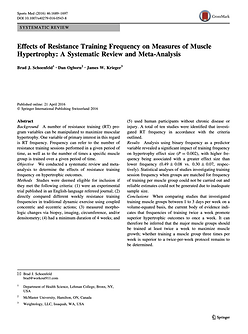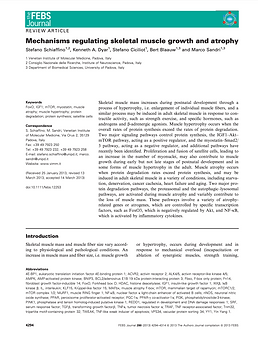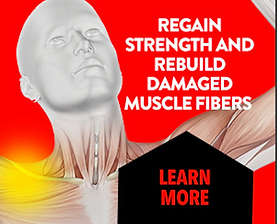
Reviews On Resistance Training & Muscle Hypertrophy

Introduction
Most recreational fitness enthusiasts perform resistance training (RT) as a means of increasing lean body mass. Maughan and colleagues [1] suggested that there is a strong relationship between muscle cross-sectional area and muscular strength. The primary goal of most strength and power athletes is to increase muscle mass especially athletes involved in strength powerlifting, rugby or American football. Additionally, increased lean muscle mass is fundamental to the sport of bodybuilding, where competitors are assessed on both the quality and quantity of their muscular growth. At a recreational level, muscle hypertrophy is pursued by the recreational RT who seek to develop their physiques to their maximum.
However, muscle hypertrophy has been reported to be limited in untrained subjects during the preliminary stages of RT, with the majority of strength gains resulting from neural adaptations [2]. Within several months of RT, hypertrophy begins to become the more central element with untrained subjects, with the upper body reporting hypertrophy before lower extremities [2, 3]. That said, hypertrophy is idiosyncratic depending on genetics, age, sex, and other aspects that have been stated to mediate the hypertrophic responses to an RT protocol. These factors affect both the degree and the total amount of gains in lean muscle mass [4]. Additionally, as subjects advance in their RT experience, progression to develop lean muscle mass becomes more difficult, heightening the need for a structured RT routine [5]. Bickel et al., [6] stated that muscle hypertrophy can be achieved through an array of RT programs. Considerations must be made towards the principle of specificity that dictates that some RT practices will stimulate greater hypertrophy in comparison to others.
Regrettably research is limited when considering the best method for attaining this goal . Different population groups implement various approaches to increase lean muscle mass. Bodybuilders elect to train with moderate loading and a reduced inter-set recovery period that induces high amounts of metabolic stress. Whereas powerlifters engage in RT with high-loading and lengthy inter-set recovery periods. Interestingly, both population groups exhibit notable muscularity, it is not evident which routine is best for maximising hypertrophic gains [7], or whether other RT methods may be superior.
Therefore, the purpose of this page is twofold: (i) to extensively provide contemporary evidence to students and academics as to the mechanisms of muscle hypertrophy and their application to RT variables ; (ii) to formulate conclusions from research and develop a hypertrophy-specific program for maximising muscle growth.
Meta-Analytical Reviews On Resistance Training & Muscle Hypertrophy (Click Image For Link)
Types of Muscle Hypertrophy
Muscle hypertrophy and muscle hyperplasia are not comparable and should be considered differently. During muscle hypertrophy the contractile elements of the sarcomere enlarge and the extracellular matrix enlarges to support growth [8]. Whereas, this is in contrast to muscle hyperplasia, which results in an increase in the number of myofibrils within the muscle. Contractile hypertrophy transpires either by adding sarcomeres in series or in parallel.
Most exercise-induced hypertrophy is a consequent of traditional RT programmes results from an increase of sarcomeres and myofibrils added in parallel [3, 9]. When the muscle is exposed to an overload stimulus, it produces perturbations in myofibres and the associated extracellular matrix. This therefore creates a series of myogenic actions that finally leads to an increase in the size and amount of the myofibrillar contractile proteins (i.e. actin and myosin), and the total number of sarcomeres in series. This subsequently leads to an increase in the diameter of individual fibres and thereby resulting in an increase in cross sectional area of the muscle [10].
A sequential increase in sarcomeres results in a particular muscle length corresponding to a shorter sarcomere length [10]. In-series hypertrophy has been suggested to ensue when muscle is required to adapt to a new functional length. Toigo and Boutelier [10] reported that when extremities were placed in a cast, where immobilisation of a joint at long muscle lengths produced an increased number of sarcomeres in series. Whereas immobilisation at shorter lengths caused a reduction. Limited evidence has also suggested that different exercises can affect the number of sarcomeres in series. For example, Lynn and Morgan [11] demonstrated that when rats performed inclined treadmill activity they had lower sarcomere count in series that those that performed decline treadmill activity. This indicates that constant eccentric-only actions lead to a greater number of sarcomeres in series, whereas exercise consisting exclusively of concentric contractions produce a serial decrease in sarcomere length [5]
Researchers have hypothesised that muscle hypertrophy may be improved by an increase in various non-contractile elements and fluids [12]. Siff and Verkhoshansky [13] termed this as ‘sarcoplasmic hypertrophy,’ and this may result in increased muscle mass exclusive of associated increases in strength. Tesch et al. [3] indicated that increases in sarcoplasmic hypertrophy are considered to be training specific, particularly when comparing muscle hypertrophy in bodybuilders to powerlifters. It has been suggested that due to differences in bodybuilders RT methodology that they generally exhibit a greater proliferation of fibrous endomysial connect tissue and a larger glycogen content compared to powerlifters [14]. Schoenfeld [5] suggests that even though sacroplasmic hypertrophy is repeatedly stated as being non-functional, it is conceivable that chronic adaptations related to cell swelling may mediate increases in protein synthesis that lead to greater contractile growth.
Antonio and Gonyea [15] suggested that increases in cross-sectional area may be partial due to increases in fibre number. A meta-analysis performed by Kelley [16] found that hyperplasia ensues in certain animal species under experimental settings as a result of mechanical overload. Further, greater muscle fibre numbers were found amongst conditions that used birds vs mammals models, and that a stretch overload protocol yielded greater increases in fibre count than exercise. That said, evidence of hyperplasia occurring in humans is restricted and if it does indeed occur then the cross-sectional area would appear to be minimal [17].
The Role Of Satellite Cells In Muscle Hypertrophy
The role of satellite cells in muscle hypertrophy has been long debated since the 1980’s. During this period it was identified that proteins remain close to the myonucleus responsible for its synthesis, giving rise to the notion of a nuclear domain. This coupled together with observations made during various models of muscle hypertrophy and the apparent activation of muscle stem cells (i.e. satellite cells activation for muscle hypertrophy).
Skeletal muscle has a remarkable capability to adapt to new functional demands. This adaptation is the mechanism manipulated by all resistance training (RT) protocols, leading to either muscle hypertrophy, elevated strength or improvement in muscular endurance.
It is important recognise that lean muscle mass is a major determinant of muscle strength but is not stable. This is because there is a continuous process of production and subsequent degradation of muscle proteins and the balance between protein synthesis and degradation determines whether hypertrophy or atrophy of muscle occurs [18]. The alteration between protein synthesis and degradation is the focus of intense research due to the many important signals, pathways and cellular adaptations that have been revealed.
It is considered by several researchers that muscle hypertrophy is mediated by the activity of satellite cells which reside between the basal lamina and sarcolemma [18, 19] (view YouTube videos). As can be seen from the clip these myogenic stem cells are dormant and become activated when appropriate mechanical stimulus is imposed on the skeletal muscle [20]. Once stimulation of satellite cells occur then they proliferate and fuse to existing cells or among themselves to produce new myofibres, providing the precursors needed for repair and growth of new muscle [10].
References
[1] Maughan, RJ, Watson, JS, and Weir, J. Strength and cross-sectional area of human skeletal muscle. J Physiol 338: 37–49, 1983.
[2] Mulligan, SE, Fleck, SJ, Gordon, SE, and Koziris, LP. Influence of resistance exercise volume on serum growth hormone and cortisol concentrations in women. J Strength Cond Res 10: 256–262, 1996.
[3] Tesch, PA. Skeletal muscle adaptations consequent to long-term heavy resistance exercise. Med Sci Sport Exerc 20(5 Suppl.): S132–S134, 1988.
[4] Kraemer, WJ, Hakkinen, K, Newton, RU, Nindl, BC, Volek, JS, McCormick, M, Gotshalk, LA, Gordon, SE, Fleck, SJ, Campbell, WW, Putukian, M, and Evans, WJ. Effects of heavy-resistance training on hormonal response patterns in younger vs. older men. J Appl Physiol. 87: 982–992, 1999.
[5] Schoenfeld BJ. The mechanisms of muscle hypertrophy and their application to resistance training. The Journal of Strength & Conditioning Research. 24(10):2857-72, 2010.
[6] Bickel, CS, Slade, J, Mahoney, E, Haddad, F, Dudley, GA, and Adams, GR. Time course of molecular responses of human skeletal muscle to acute bouts of resistance exercise. J Appl Physiol 98: 482– 488, 2005.
[7] Schott, J, McCully, K, and Rutherford, OM. The role of metabolites in strength training. II. Short versus long isometric contractions. Eur J Appl Physiol 71: 337–341, 1995.
[8] Vierck, J, O’Reilly, B, Hossner, K, Antonio, J, Byrne, K, Bucci, L, and Dodson, M. Satellite cell regulation following myotrauma caused by resistance exercise. Cell Biol Int 24: 263–272, 2000.
[9] Paul, AC and Rosenthal, N. Different modes of hypertrophy in skeletal muscle fibers. J Cell Biol 18: 156: 751–760, 2002.
[10] Toigo, M and Boutellier, U. New fundamental resistance exercise determinants of molecular and cellular muscle adaptations. Eur J Appl Physiol 97: 643–663, 2006.
[11] Lynn, R and Morgan, DL. Decline running produces more sarcomeres in rat vastus intermedius muscle fibers than does incline running. J Appl Physiol 77: 1439–1444, 1994.
[12] MacDougall, JD, Sale, DG, Alway, SE, and Sutton, JR. Muscle fiber number in biceps brachii in bodybuilders and control subjects. J Appl Physiol 57: 1399–1403, 1984.
[13] Siff, MC and Verkhoshansky, YV. Supertraining (4th ed.). Denver, CO: Supertraining International, 1999.
[14] MacDougall, JD, Sale, DG, Elder, GC, Sutton, JR. Muscle ultrastructural characteristics of elite powerlifters and bodybuilders. Eur J Appl Physiol Occup Physiol 48: 117–126, 1982.
[15] Antonio, J and Gonyea WJ. Role of muscle fiber hypertrophy and hyperplasia in intermittently stretched avian muscle. J Appl Physiol 4: 1893–1898, 1993.
[16] Kelley, G. Mechanical overload and skeletal muscle fiber hyperplasia: A meta-analysis. J Appl Physiol 81: 1584–1588, 1996.
[17] Abernethy, PJ, Jurimae, J, Logan, PA, Taylor, AW, and Thayer, RE. Acute and chronic response of skeletal muscle to resistance exercise. Sports Med 17: 22–38, 1994.


















